By Erin Craig
I sat at the long wooden table in Moolmaru Traditional Soybean Paste School on Jeju island, South Korea, adjusting my apron and catching side-eye from a toddler. Apparently I’d misread the demographic for this class; most of my fellow students looked like they were cutting nursery school to be there. Chalk it up to my questionable Korean skills – but at least I’d be able to keep up with the class. Probably.
Gochujang is a slow fuse to sudden ignition
I was there to learn how to make gochujang, my current favourite food. Gochu is the Korean word for chilli; jang means fermented paste or sauce. This dangerously red chilli paste is the backbone of South Korea’s spicy-sweet flavours, and it brings heat to famous dishes like barbecue, bibimbap, budae-jjigae, yangnyeom fried chicken and the tongue-blistering rice cake dish tteokbokki. Gochujang is a slow fuse to sudden ignition – used correctly, the heat never reaches your mouth but amplifies surrounding flavours to surreal levels. Of course, sometimes it’s fun to go for the burn.
At first, my obsession was just ego: me against the persistent Korean myth that Westerners don’t like spicy food. Historically speaking, they have a point. One of the first Westerners to write about Korea was Victorian adventuress Isabella Bird back in the 1890s. She was horrified by the “sauces of pungent and objectionable odours, the basis of most of them being capsicums and fermented rotten beans!”
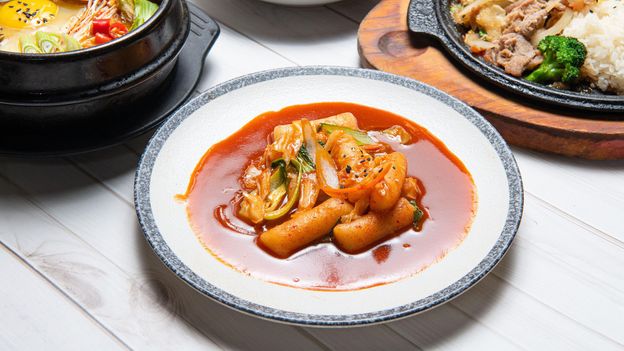
Tteokbokki, a tongue-blistering rice cake dish, is made with gochujang paste
Thankfully, tastes – and attitudes – have changed. Today, gochujang is a hot item in the UK and US, popping up on flavour trend forecasts by everyone from food wholesaler Bidfood to the National Restaurant Association. Often billed as the “new sriracha”, it’s made the leap from specialty stores to big-box supermarkets and fast food joints.
This is no accident. Gochujang companies have spent the last decade developing their export strategy. Within South Korea, gochujang is sold in its raw form, a base ingredient for sauces, marinades and stews. But the dense, sticky paste was reimagined as a squeeze-bottle condiment for the Western market, often combined with other sauces like mayonnaise to make it more familiar. The heat was scaled back too. Gochujang manufacturers even teamed up with the Korean Food Research Institute to create a new measure of spiciness called the GHU (Gochujang Hot-taste Unit). It worked: in 2018, South Korean gochujang exports were worth $36.81 million – up 15% on the previous year – with much of it going to the UK and US.
Yet the true attraction isn’t heat, but complexity. Gochujang hits several different flavours at once – spicy, yes, but also sweet and salty with an underlying umami note called gamchilmat in Korean. It’s an irreplaceable taste; maybe that’s why 21% of South Koreans pack gochujang when travelling abroad, according to Yonhap News Agency.
While gochujang is distinctly Korean, chillies are not. They arrived in the late 1500s, having hitched a ride out of the Americas with early European explorers 100 years earlier and worked their way around the world. Scientifically they are of the species Capsicum annuum L., which is the largest of the five species of domesticated chillies and also includes jalapeños.
The first written record of gochujang was recorded by royal physician Si-pil Yi in the 1720s in a compendium of foods eaten at court. It’s a recipe for Sunchang gochjang, referencing a region still famous for the chilli paste today.
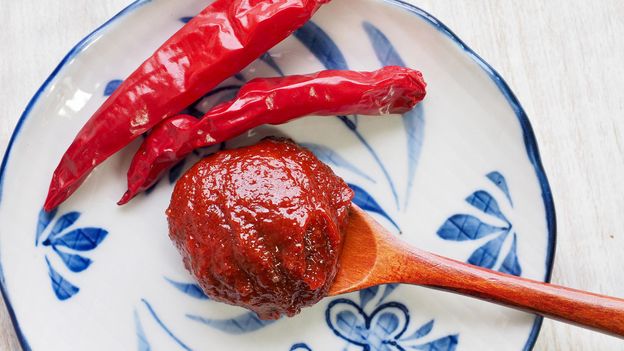
Gochujang is the backbone of South Korea’s spicy-sweet flavours (Credit: sungsu han/Alamy)
Roughly 230km south of Seoul, Sunchang celebrates its culinary heritage with an annual festival at the Gochujang Village. There’s also the Sunchang Traditional Paste Museum, located at 43 Jangnyu-ro, which translates as “Fermented Pastes Road”. There, cultural tour guide Won-jun Yang filled me in on why Sunchang gochujang was considered fit for a king.
“There are three reasons Sunchang gochujang is so good,” explained Yang, who also writes about gochujang for Sunchang County’s website. “First, most regions make gochujang in the spring, but Sunchang gochujang is made during the 8th and 9th lunar months and ferments through the winter. Second, the water in this region is delicious. Third, Sunchang has more than 77 foggy days every year – the air holds water like a sponge which is good for bacteria and fermentation.”
And those bacteria are good for us. From the start, gochujang was used as a medicinal food, especially for digestive problems. It was even credited with saving King Yeongjo’s life in 1748 – perhaps a bit of an oversell, but those ancient doctors were on the right track. Today, we know naturally fermented foods are great for your gut, and soy-based Korean jangs are associated with a range of benefits from lowering cholesterol to fighting cancer.
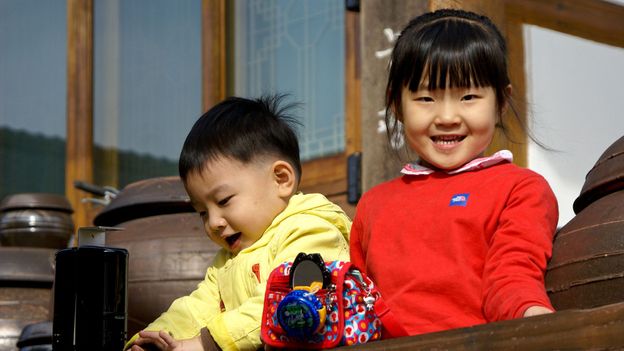
Children are taught how to make gochujang to help preserve its heritage (Credit: Michele Burgess/Alamy)
But gochujang quickly moved beyond medicine to become a defining flavour of Korean cuisine. Throughout the 18th Century, it appeared in imperial records, home management books and even poetry. By the end of the 19th Century, it was a universal staple – Isabella Bird reported that gochujang was consumed by all ages, even babies.
I thought about this as a pre-schooler helped me sound out the ingredient list in our cooking class. With our matching brown aprons and elementary reading levels, I seemed to be fitting in just fine.
A large window looked out on the school courtyard, which was filled with massive clay fermentation pots called onggi. When Moolmaru’s founder Jeong-seon Bu was growing up, most families had onggis of homemade soy and chilli pastes in their gardens. Nowadays, Koreans generally live in apartments and buy their gochujang in plastic tubs that slide easily into the fridge. That’s one of the reasons Bu, who holds three patents for her jang-making process, founded Moolmaru in 2005. She worries the homemade taste is disappearing from the Korean palate.
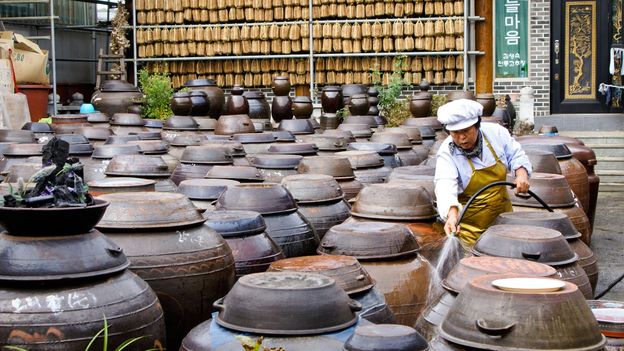
Gochujang is fermented in massive clay pots called onggi (Credit: Michele Burgess/Alamy)
“Education is important to preserving this heritage,” she said, adding that while she teaches all age groups, she likes to focus on preschool-aged kids. “Children are very sensitive to taste. It’s the perfect time to teach the taste of really well-fermented jang.”
Education is important to preserving this heritage
Bu clearly knew her audience. The first step to making gochujang is mashing boiled soybeans, the base ingredient of all Korean jang. She insisted we do this the old-fashioned way, and the kids joyously stomped the beans to mush under snowy white galoshes. This was patted into rounded bricks called meju and laid to rest on a bed of rice straw.
It takes 40 days for meju to ferment and dry, absorbing good fungi and bacteria rather like sourdough starter on a kitchen counter. Then the bricks are ground down and combined with gochugaru, a chili powder made from sun-dried red peppers. The only other ingredients in Bu’s recipe are vegetable stock, salt, barley powder for sweetness, a bit of fruit enzyme to aid fermentation, and a starch that determines the final product’s name: Bu uses ssal (rice), so hers is ssal gochujang.
Then the paste goes in an onggi to ferment. “Onggis are alive. They breathe,” said Bu, referencing the porous clay that allows airflow. “It’s the perfect environment for good microorganisms.” The gochujang is ready to eat after one year, but Bu recommends two for a mature taste. More and the paste becomes bitter.
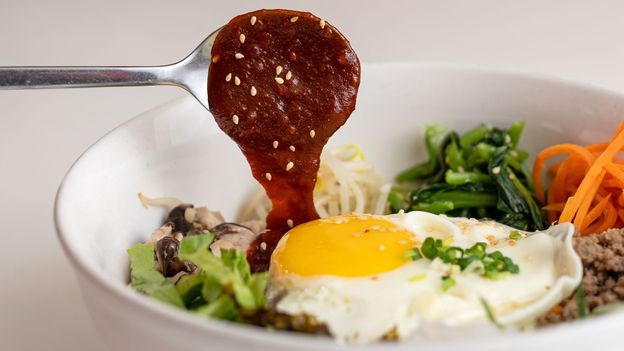
Gochujang brings heat to famous Korean dishes like bibimbap (Credit: Justin Ong/Getty Images)
My squirmy classmates were definitely not going to wait that long, so we whipped up a zingy quick-mix version with garlic, fresh ginger and pickled cucumber. Bu also demonstrated a chilli dipping sauce that included beetroot, broccoli powder and kiwi compote – not the ingredients I expected from a traditionalist.
I asked Bu’s opinion of the squeezable gochujangs and spicy mayo blends trending in the West, which promote Korean cuisine while moving further away from that original homemade taste. To my surprise, she’s all for it. She has even been developing a few fusion mixes herself, like a gochujang-ketchup spread that incorporates local black pork.
“It’s a good opportunity to create new food culture,” she said with a smile. And a new generation of gochujang lovers, I thought, glancing at my diminutive fellow cooks. I guess this was the class for me after all.
Culinary Roots is a BBC Travel series that looks at trending recipes and traces their origins, offering the story behind the dish as well as easy tips on how to make them.

No comments:
Post a Comment